Related Research Articles
Keretapi Tanah Melayu Berhad (KTMB) or Malayan Railway Limited, colloquially referred to simply as KTM, is the main rail operator in Peninsular Malaysia. The railway system dates back to the British colonial era, when it was first built to transport tin. Previously known as the Federated Malay States Railways (FMSR) the Malayan Railway Administration (MRA), and the Malayan Railway, Keretapi Tanah Melayu acquired its current name in 1962. The organisation was corporatised in 1992, but remains wholly owned by the Malaysian government.

Ipoh is the capital city of the Malaysian state of Perak. Located by the Kinta River, it is nearly 200 km (120 mi) north of Kuala Lumpur and 150 km (93 mi) southeast of George Town in neighbouring Penang. As of the 2020 census Ipoh had a population of 759,952, making it the eighth-largest city in Malaysia by population.

Negeri Sembilan, historically spelled as Negri Sembilan, is a state in Malaysia which lies on the western coast of Peninsular Malaysia. It borders Selangor on the north, Pahang in the east, and Malacca and Johor to the south.

The Jelebu District is the second largest district in Negeri Sembilan, Malaysia after Jempol, with a population over 40,000. Jelebu borders on the Seremban District to its west and Kuala Pilah District to its south, Jempol District to its southeast, Bentong and Bera Districts, Pahang to its east and Hulu Langat District, Selangor to the north. Jelebu is a suburban district with blossoming semi-agricultural industry. Jelebu is also a parliamentary constituency of the Dewan Rakyat in the Malaysian Parliament. Kuala Klawang is the principal town of the district.
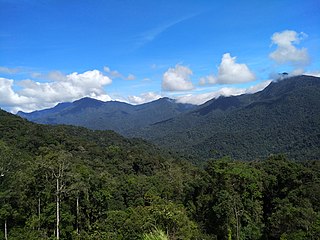
The Titiwangsa Mountains, also known as Banjaran Besar by locals, is the chain of mountains that forms the backbone of the Malay Peninsula. The northern section of the range is in southern Thailand, where it is known as the Sankalakhiri Range.
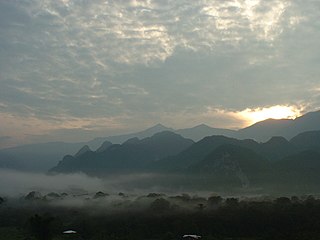
The Gunung Mulu National Park, also known simply as the Mulu National Park is a national park in Miri Division, Sarawak, Malaysia. It is a UNESCO World Heritage Site that encompasses caves and karst formations in a mountainous equatorial rainforest setting. The park is famous for its caves and the expeditions that have been mounted to explore them and their surrounding rainforest, most notably the Royal Geographical Society Expedition of 1977–1978, which saw over 100 scientists in the field for 15 months. This initiated a series of over 20 expeditions now named the Mulu Caves Project.

The Gombak District is an administrative district located in the state of Selangor, Malaysia. The district was created on February 1, 1974, the same day when Kuala Lumpur was declared a Federal Territory. Until 1997, Rawang was the district capital; the capital has been moved to Bandar Baru Selayang. Gombak borders Kuala Lumpur to the southeast and the Genting Highlands to the east. Both Gombak and Kuala Lumpur, along with some other districts in Selangor, are situated within the Klang Valley. Other localities in Gombak district include Batu Arang, Kuang, Rawang, Kundang, Gombak Town, Selayang, Batu Caves and Hulu Kelang.
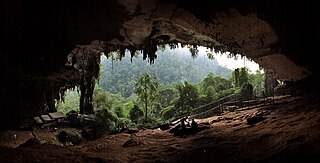
Niah National Park, located within Miri Division, Sarawak, Malaysia, is the site of the Niah Caves which are an archeological site.
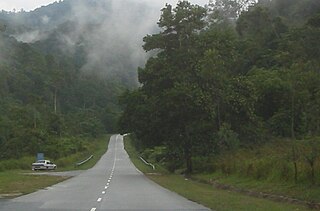
Lenggong or Lenggong Valley is a geographical area defined by the mountain ranges of Bintang in the west and Titiwangsa to its east. It is a rural area, with small kampongs surrounded by green vegetation and limestone hills with numerous caves.
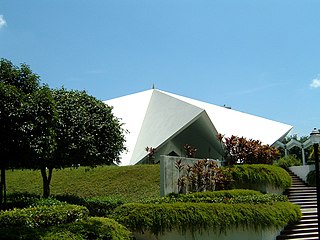
This article lists important figures and events in Malaysian public affairs during the year 1973, together with births and deaths of notable Malaysians.
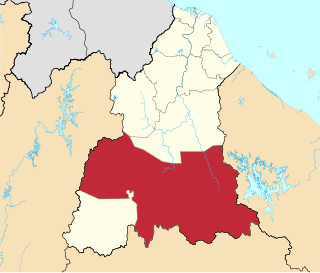
Gua Musang is a town, district and parliamentary constituency in southern Kelantan, Malaysia. It is the largest district in Kelantan. Gua Musang is administered by the Gua Musang District Council. Gua Musang district is bordered by the state of Pahang to the south, Terengganu to the east, Perak to the west and the Kelantanese districts of Kuala Krai and Jeli to the north. It is a small railway town about 140 km south of state capital Kota Bharu. Gua Musang is represented by Mohd Azizi Abu Naim in the Dewan Rakyat. The town lies on the KTM East Coast Line, from Tumpat, near the border with Thailand, to Gemas, Negeri Sembilan.
Mount Benarat is a mountain located in Gunung Mulu National Park in Sarawak, Malaysia, consisting of limestone on the western side which is overlain by gritstone on the eastern side. It contains many caves which have been discovered and explored by British and American cavers. The Benarat 2005 Caving Expedition discovered Moon Cave after climbing 60 m up the cliffs on the southern end of the mountain. On the eastern side, the Headhunter's Trail leads from the Melinau River to the mouth of the Terikan River at the Medalam River. Neighbouring Mount Buda and Mount Api are part of the same formation, separated from Mount Benarat by the Medalam and Melinau Rivers, respectively. It is also home to Benarat Cavern.

Tourism in Malaysia is a major industry and contributor to the Malaysian economy. Malaysia was once ranked 9th in the world for tourist arrivals. In 2017, the Travel and Tourism Competitiveness Report ranked Malaysia 26 out of 141 countries using its Travel & Tourism Competitiveness Index (TTCI) which measures the various components and policies of a country that are in place to allow for the sustainable development of its travel and tourism sectors.
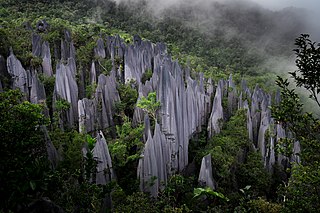
Mount Api is a limestone mountain located in Gunung Mulu National Park in Sarawak, Malaysia. Neighbouring Mount Benarat and Mount Buda are part of the same formation. Mount Api is famous for its striking limestone karst formations, commonly called "the pinnacles".

Deer Cave, located near Miri, Sarawak, Malaysia, is a show cave attraction of Gunung Mulu National Park. It was surveyed in 1961 by G. E. Wilford of the British Borneo Geological Survey, who predicted that Mulu would yield many more caves in the future. The cave, which is also known as Gua Payau or Gua Rusa by the local Penan and Berawan people, is said to have received its name because of the deer that go there to lick salt-bearing rocks and shelter themselves.

Mining is one of the main industries in Malaysia. Malaysia produces aggregate, bauxite, clay, coal, copper, feldspar, gold, gravel, ilmenite, iron ore, kaolin, limestone, mica, monazite, sand, silica sand, struverite and tin.

Tambun rock art, is a series of Neolithic-era cave paintings at the Gunung Panjang limestone hill in Tambun, on the outskirts of Ipoh, Perak, Malaysia. The paintings were discovered on a rocky overhang in 1959 by 2/Lt R. L. Rawlings of the 2nd Battalion, 6th Queen Elizabeth's Own Gurkha Rifles. Popularly known as the "Tambun Cave Paintings", the paintings could have been made by the ancestors of the Orang Asli and had spiritual importance. This site should not be confused with Gunung Tambun, another limestone hill that is found several kilometres to the north of Gunung Panjang.
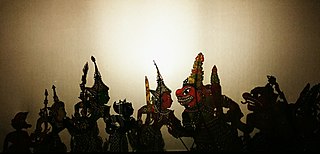
Malaysian folklore is the folk culture of Malaysia and other indigenous people of the Malay Archipelago as expressed in its oral traditions, written manuscripts and local wisdoms. Malaysian folklores were traditionally transmitted orally in the absence of writing systems. Oral tradition thrived among the Malays, but continues to survive among Orang Asli and numerous Bornean ethnic groups in Sarawak and Sabah. Nevertheless, Malaysian folklores are closely connected with classical Malay folklore of the region. Even though, Malay folklore tends to have a regional background, with the passing of time, and through the influence of the modern media, large parts of regional Malay folklore have become interwoven with the wider popular Malaysian folklore.
References
- ↑ Liew, Thor-Seng; Price, Liz; Clements, Gopalasamy Reuben (2016). "Using Google Earth to Improve the Management of Threatened Limestone Karst Ecosystems in Peninsular Malaysia" (PDF). Tropical Conservation Science. 9 (2): 903–920. doi: 10.1177/194008291600900219 . ISSN 1940-0829.
- ↑ Halim, Mohd Hasfarisham Abd; Gorip, Mohd Aziz; Muhamad, Rasydan (2022-12-30). "ARCHAEOLOGICAL EVIDENCE OF GUA PELANGI, JELEBU, NEGERI SEMBILAN, MALAYSIA: ITS POTENTIAL AS A HERITAGE TOURISM SITE" (PDF). GeoJournal of Tourism and Geosites. 44 (4): 1282–1291. doi:10.30892/gtg.44412-944.